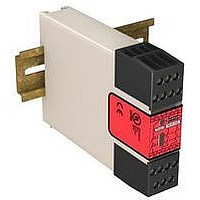ES-FA-11AA BANNER ENGINEERING, ES-FA-11AA Datasheet - Page 3

ES-FA-11AA
Manufacturer Part Number
ES-FA-11AA
Description
98H7885
Manufacturer
BANNER ENGINEERING
Datasheet
1.ES-FA-11AA.pdf
(16 pages)
Specifications of ES-FA-11AA
Coil Voltage Vac Nom
24V
Coil Voltage Vdc Nom
24V
Contact Current Max
7A
Contact Voltage Ac Nom
250V
Contact Voltage Dc Nom
250V
No. Of Poles
2
Relay Mounting
DIN Rail
External Height
80mm
ES-FA-9AA / ES-FA-11AA E-Stop Safety Modules
Safety Circuit Integrity and ISO 13849-1 Safety Circuit Principles
Safety circuits involve the safety-related functions of a machine that minimize the level of risk of harm. These safety-
related functions can prevent initiation, or they can stop or remove a hazard. The failure of a safety-related function
or its associated safety circuit usually results in an increased risk of harm.
The integrity of a safety circuit depends on several factors, including fault tolerance, risk reduction, reliable and well-
tried components, well-tried safety principles, and other design considerations.
Depending on the level of risk associated with the machine or its operation, an appropriate level of safety circuit
performance (i.e., integrity) must be incorporated into its design. Standards that detail safety performance levels
include ANSI/RIA R15.06, ANSI B11, OSHA 29CFR1910.217, and ISO 13849-1 (EN954-1).
Safety Circuit Integrity Levels
Safety circuits in international and European standards are segmented into categories, depending on their ability to
maintain their integrity in the event of a failure. The most recognized of these standards is ISO 13849-1 (EN954-1),
which establishes five levels: Categories B, 1, 2, 3, and the most stringent, Category 4.
In the United States, the typical level of safety circuit integrity has been called "control reliability." Control reliability
typically incorporates redundant control and self-checking circuitry and has been loosely equated to ISO 13849-1
Categories 3 and 4 (see CSA Z432 and ANSI B11.TR4).
If the requirements described by ISO 13849-1 are to be implemented, a risk assessment must first be performed to
determine the appropriate category, in order to ensure that the expected risk reduction is achieved. This risk assess-
ment must also take into account national regulations, such as U.S. control reliability or European "C" level standards,
to ensure that the minimum mandated level of performance is complied with.
Fault Exclusion
An important concept within the category requirements of ISO 13849-1 is the "probability of the occurrence of the
failure," which can be decreased using a technique termed "fault exclusion." The rationale assumes that the possi-
P/N 060606 rev. E
An Emergency Stop Safety Module is used to increase the control relia-
bility of an emergency stop circuit. As shown in the hookup drawings,
the models ES-FA-9AA and ES-FA-11AA E-Stop Safety Modules are
designed to monitor a 1-channel or 2-channel E-stop switch. A 2-channel
E-stop switch has two electrically isolated contacts.
Banner Engineering Corp. - Minneapolis, MN USA - www.bannerengineering.com
Overview
Tel: 763.544.3164
Figure 1: Features and terminals
Active LED
Active LED
Power ON
Channel 1
Channel 2
LED
ES-FA-9AA
ES-FA-11AA
3















